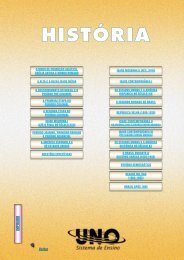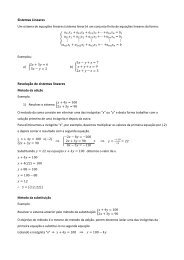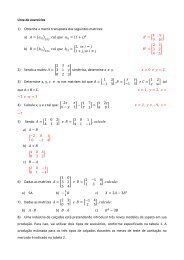inglês tests with no relation with texts - Prof. Ms. Aldo Vieira
inglês tests with no relation with texts - Prof. Ms. Aldo Vieira
inglês tests with no relation with texts - Prof. Ms. Aldo Vieira
Create successful ePaper yourself
Turn your PDF publications into a flip-book with our unique Google optimized e-Paper software.
42<br />
GABARITO<br />
IMPRIMIR<br />
174. Med. Itajubá-MG Qual a melhor tradução para “to curry public favor”?<br />
a) Por apressar o favor do público.<br />
b) Para conquistar a aprovação do público.<br />
c) Favorecer o público para correr.<br />
d) Publicar o favor conseguido.<br />
e) Para ocorrer ao público favor.<br />
175. Med. Itajubá-MG Qual o melhor antônimo para “ostentatious”?<br />
a) Controverso.<br />
b) Alardoso.<br />
c) Flagrante.<br />
d) Ostensivo.<br />
e) Comedido.<br />
176. Med. Itajubá-MG Marque a opção que dá mais exatamente o oposto de “… while the<br />
hapless costomer watched the flames spread.”<br />
a) … assim que as chamas se propaguem.<br />
b) … antes que o venturoso freguês veja o fogo apagar-se.<br />
c) … enquanto olhava as chamas que subiam.<br />
d) … <strong>no</strong> momento em que as chamas subiam, era infeliz.<br />
e) … o comprador, por sorte, via o fogo espalhar-se.<br />
177. Med. Itajubá-MG “He threw his money around”. This same sentence in the past perfect<br />
continuous would be:<br />
a) He threwed his money around.<br />
b) He would throw his money around.<br />
c) He had been throwing his money around.<br />
d) He will be throwing his money around.<br />
e) He has thrown his money around.<br />
What’s in a smile<br />
Smiling is…<br />
universal. In his travels, Charles Darwin discovered that smiling was the only facial expression<br />
which was recognised instantly all over the world.<br />
easy to see. It is possible to recognise a smile on someone’s face at a distance of 45 metres.<br />
You’d have to be much closer to decide whether the person was showing surprise, anger or<br />
fear.<br />
simple. You only use one facial muscle to smile. This is the zygomatic major muscle, which<br />
reaches down from the cheekbone to the corners of the lips. To look sad or angry, you need<br />
to use at least two muscles.<br />
good for you. Studies in the USA have shown that when you smile your heart rate slows down,<br />
your blood pressure goes down and the body begins to relax. This happens whether you are<br />
feeling happy or <strong>no</strong>t. In fact, if you’re feeling unhppy, the simple act of smiling is the first step<br />
to feeling better.<br />
attractive. According to American dentists Melvin and Elaine Denholtz, an attractive smile should<br />
show most of the upper teeth, at least two thirds of the length, and just the tips of the lower<br />
teeth.<br />
(<br />
(<br />
(<br />
(<br />
(<br />
Voltar<br />
(DOFF, Adrian & JONES, Christopher. Language in use. Intermediate. Cambridge: Cambridge University Press, 1994.)<br />
INGLES - Text – related <strong>tests</strong><br />
Avançar









